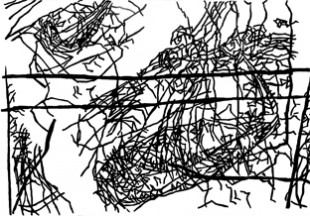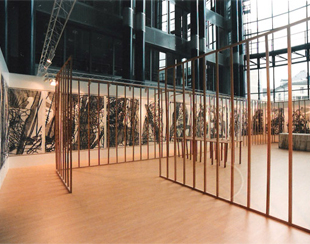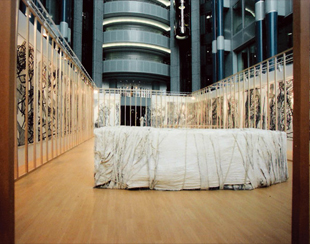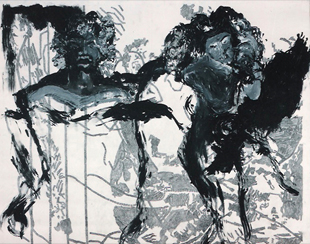It’s all in black and white
by David Rapp Haaret'z. November 25, 2002

Sheinman’s artistic career follows the process she has undergone in her personal life: unraveling the truth from the tangle of secrets and lies of her childhood.
The Museum of Israeli art in Ramat Gan is showing Sheinman’s recent work, done over the last three years, in which her compact artistic language has reached a peak.
Sheinman studied at the Avni institute under Yehezkel Streichman and moshe Sternschuss, later abandoning figurative art for the abstract, under the tutelage of Chaim kiewe. The current exhibit consists of enormous stretches of canvas covered with squiggles in black graphite. No figures, no colors. Just black lines on white canvas.
Now you see, now you don’t see
by Hana Kofler, English Translation: Richard Flanz, Daria Kassovsky

In the present installation – Interior space- Daniella Sheinman presents a new spectacle, which in one stroke abolishes every previous framework.
In the new three-dimensional territory, Sheinman expands her field of activity, but concurrently and insistently she eliminates color, posits a limit, blocks visibility.
But the bursting of the two -dimensional framework is revealed as a momentary illusion of freedom.
“Now you see, now you don’t see is the name of the game. The installation Interior Space is concentrated around three dimensional elements, the affinity among which is created by virtue of the paradox that characterized the components of each, as well as the complexity of the connections among them.
The scroll that enwraps the outer limit of the space and closes upon the cage which closes upon the mummy enclosed in Its shrouds creates an installation that deals with man’s existential situation. Here, every possible option cancels out the other, and the viewer who finds himself inside this web can do nothing but take in part in the only possibility given him – the freedom of the game.
Interior space
Yediot Aharonot newspaper. Exhibition column. Critic: Nitza Aviram 9th October 1996

The exhibition is a huge installation under the name of ‘Now you see, Now you don’t’, and has won unprecedented success.
Sheinman is one of the few women who make up the list of presenters at the prestigious German Bank, and the only Israeli women to have” infiltrated” this bank “Museum”. The fact that the exhibition took place in the German bank is considered an impressive achievement on an international level, due it being one of the biggest banks in Germany and which sees art as one of the most important principles on which Its business image is based.
Her new fantasy was to work in a large scale. To go on one creation, “as big as possible :” After working a few months on models which displayed the new creative direction that “burned in her bones”, Sheinman searched for a suitable site in large Museum outside Israel’s borders. She soon found that the large Banks in Germany also serve as museum, art collectors and sponsors for artists. “every prestigious bank in Germany has a treasury Department. This is tradition that exists in all of Europe within the framework of the openness to art and the will to grant a stage for artists.
On Daniella Sheinman’s painting exhibition
By Dr. Michael Sgan Cohen Haifa Museum of art 1991-1993

If one looks carefully on Daniella sheinman’s paintings, it will be discovered, sooner or later, that the “couple interaction” at the core of her work is the expulsion from the Garden of Eden, not the event itself but, as the learned observer knows, that of the Renaissance artist Masaccio, wich was part of the famous fresco cycle wich he painted in the Brancacci Chapel in Florence in 1427.
There is no doubt that this is one of the most forceful paintings produced by the west, but this is not the place to present Masaccio’s full importance. It is obvious that Masaccio gave, especially to painting, a new kind of monumentalism and force, and a special presence and physical mass. He presented a proposition for painting which was then considered less monumental and thus of less importance as a medium than sculpture. But Masaccio is important not only for the formal aspect of his assertion, but also the engrossing psychological and human description of the new man, his feelings of frustration and pain, fully exposed and vulnerable in his nudity. Flesh and blood. Masaccio’s expulsion scene, perhaps more than any other expulsion scene, presents the psychological dimension which he brought to the renewed painting of the Italian Renaissance. The scene has great force and it is not surprising that even an artist such as the “divine” Michelangelo was influenced by it when he himself approached the subject. It is therefore e possible to view this scene by Masaccio as man looking at himself, as a born again child expelled from the giant’s garden if to relate to Oscar wild’s story and thus to modern iconography.
 Daniella Sheinman
Daniella Sheinman